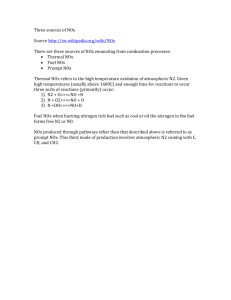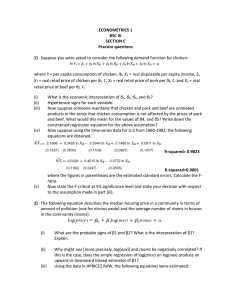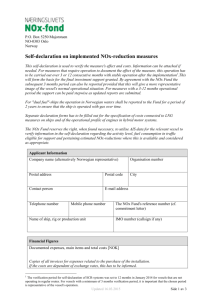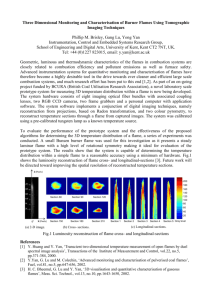COMBUSTION AND EMISSION CHALLENGES AT LKAB
advertisement
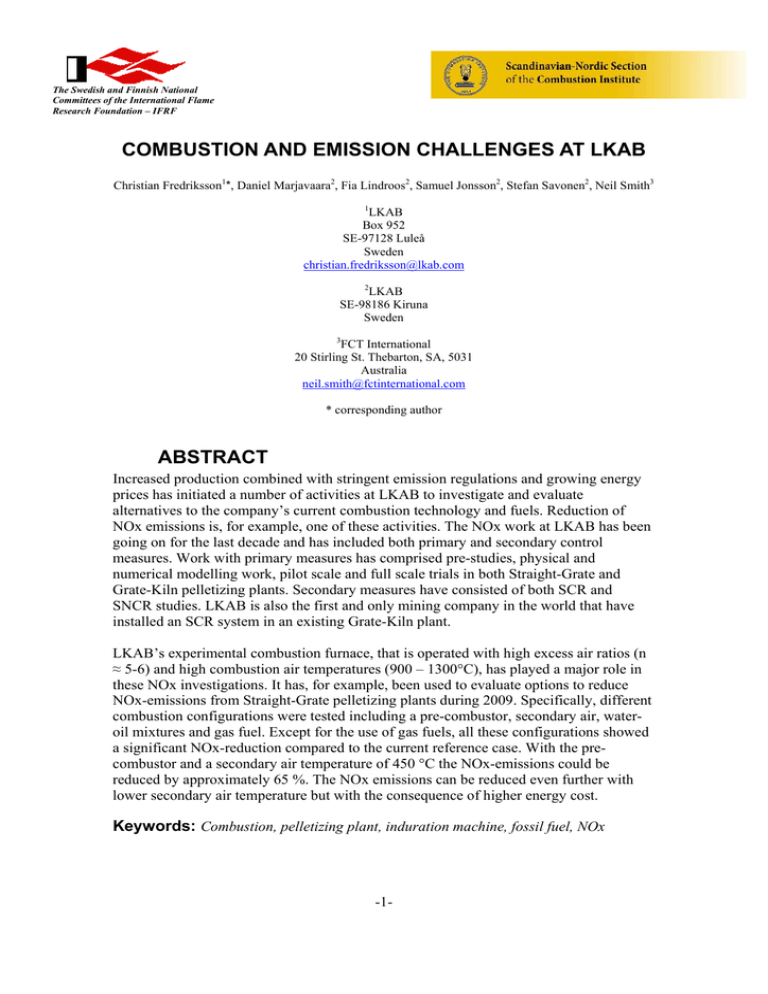
The Swedish and Finnish National Committees of the International Flame Research Foundation – IFRF COMBUSTION AND EMISSION CHALLENGES AT LKAB Christian Fredriksson1*, Daniel Marjavaara2, Fia Lindroos2, Samuel Jonsson2, Stefan Savonen2, Neil Smith3 1 LKAB Box 952 SE-97128 Luleå Sweden christian.fredriksson@lkab.com 2 LKAB SE-98186 Kiruna Sweden 3 FCT International 20 Stirling St. Thebarton, SA, 5031 Australia neil.smith@fctinternational.com * corresponding author ABSTRACT Increased production combined with stringent emission regulations and growing energy prices has initiated a number of activities at LKAB to investigate and evaluate alternatives to the company’s current combustion technology and fuels. Reduction of NOx emissions is, for example, one of these activities. The NOx work at LKAB has been going on for the last decade and has included both primary and secondary control measures. Work with primary measures has comprised pre-studies, physical and numerical modelling work, pilot scale and full scale trials in both Straight-Grate and Grate-Kiln pelletizing plants. Secondary measures have consisted of both SCR and SNCR studies. LKAB is also the first and only mining company in the world that have installed an SCR system in an existing Grate-Kiln plant. LKAB’s experimental combustion furnace, that is operated with high excess air ratios (n ≈ 5-6) and high combustion air temperatures (900 – 1300°C), has played a major role in these NOx investigations. It has, for example, been used to evaluate options to reduce NOx-emissions from Straight-Grate pelletizing plants during 2009. Specifically, different combustion configurations were tested including a pre-combustor, secondary air, wateroil mixtures and gas fuel. Except for the use of gas fuels, all these configurations showed a significant NOx-reduction compared to the current reference case. With the precombustor and a secondary air temperature of 450 °C the NOx-emissions could be reduced by approximately 65 %. The NOx emissions can be reduced even further with lower secondary air temperature but with the consequence of higher energy cost. Keywords: Combustion, pelletizing plant, induration machine, fossil fuel, NOx -1- The Swedish and Finnish National Committees of the International Flame Research Foundation – IFRF 1. INTRODUCTION Luossavaara-Kiirunavaara AB (LKAB) is an international high-tech minerals group, one of the world’s leading producers of upgraded iron ore products for the steel industry and a growing supplier of industrial minerals products to other sectors. In the process to produce iron ore pellets, the iron ore pellets (mainly magnetite) undergo heat treatment in a pelletizing plant where they are dried, oxidized and sintered to obtain the correct properties. The outgoing product is then used in blast furnaces or direct reduction furnaces of steel plants. The heat in the pelletizing plant is today generated by combustion of fossil fuels such as heavy fuel oil and coal. Increased production combined with stringent emission regulations and growing energy prices have initiated a number of activities at LKAB to investigate and evaluate alternatives to the company’s current combustion technology and fuels. A division, Energy and Emissions (TLE), was for example, started in 2006 to work with these questions. During the last decade LKAB has been working on both primary and secondary methods to reduce NOx emissions from the company’s pelletizing plants. Compared to conventional heat generation plants the specific emissions of NOx are higher due to the high excess air ratios (n ≈ 5-6) and high combustion air temperatures (900 – 1300°C). Work with primary measures has comprised pre-studies, physical and numerical modelling work, pilot scale and full scale trials in both Straight-Grate and Grate-Kiln pelletizing plants. As secondary measures LKAB installed 2008 the world’s first and the only SCR system in a Grate-Kiln plant, which is still being evaluated. Another secondary measure that has been tested in an existing plant is the SNCR technology, with an instantaneous reduction level of 15% or less depending on temperature. This paper will focus on the work that has been done to test and evaluate primary NOxreduction techniques for Straight-Grate plants. Specifically the paper will present the method, result and conclusions from the pilot trials in LKAB’s experimental combustion furnace (ECF). 1.1 Straight-Grate plants In a Straight-Grate induration machine balled pellets made from a mixture of iron ore, additives and water (so called green pellets or wet pellets) are transported throughout the machine in order to be indurated, see Figure 1. The drying, oxidization and sintering in an induration machine is typically done in four zones, i.e. the drying zone (UDD and DDD) where the green pellets are dried, the preheating zone (PH) where most of the pellets are oxidized, the firing zone (F) were the oxidized pellets are sintered and the cooling zone (C and C2) where the pellets are cooled down before transportation to the harbour. The external heat required for the process is generated in the preheating (PH) and firing zone (F) by combustion of external fuels. It is also here most of the NOx is formed. The large excess air ratios and high temperatures in the secondary air (from the cooling section) that passes through the downcomers and combustion chamber affect the magnitude of the formed NOx, see Figure 2. Hence, the design of the burner and -2- The Swedish and Finnish National Committees of the International Flame Research Foundation – IFRF combustion chamber is important to minimize the NOx emissions. Results from tests with different modifications of the burner and combustion chamber system are presented in this paper. Figure 1. Sketch of an indurating machine in a Straight-Grate plant. Figure 2: Cross-section of the induration machine in the burner section. 1.2 NOx emission reduction methods NOx emissions from the oil burners in the MK3 grate kiln are mostly from the thermal mechanism due to the high peak flame temperatures and high oxygen concentrations. Flames are short and intense and of high temperature because the oil is sprayed directly into a hot co-flowing air stream. Some fuel NOx is also formed. The maximum nitrogen content of the heavy fuel oil is 0.3%. In the worst case scenario where all of the fuelbound nitrogen is oxidised into NOx, fuel NOx will contribute to about 20% of the total current NOx emissions. -3- The Swedish and Finnish National Committees of the International Flame Research Foundation – IFRF Thermal NOx formation scales exponentially with temperature and has a weaker dependence on oxygen concentration [1]. Consequently, modification of a combustion process to reduce thermal NOx is most effective when peak flame temperatures are reduced. This can be achieved by limiting the rate of mixing of air and fuel, and can also include either fuel staging or air staging. Staging controls both fuel and thermal NOx by reducing the availability of oxygen in the high-temperature regions in the flame. Air staging generates lower temperatures in the initial fuel-rich stage than in flames with excess air by limiting the rate of the combustion reactions due to the low availability of oxygen. As a consequence, air staging is an effective means of reducing thermal NOx emissions. Air staging is also commonly used for reduction of fuel NOx, where supply of approximately 60% of stoichiometric air to the fuel rich stage has been shown to be the optimal level to force fuel N reactions to produce molecular N2 rather than NO [2]. The aim of the current work is to quantify the NOx reductions that can be obtained in a pilot scale model of an MK3 downcomer / burner arrangement by various methods. These methods include air staging by burning some of the fuel in a pre-combustor with a limited air supply, use of water to cool the flame and use of gaseous fuels instead of oil. 2. Method 2.1 LKAB experimental pilot scale furnace Experiments with different NOx combustion configurations were conducted at LKAB’s pilot scale facility ECF in Luleå. The ECF was originally designed to provide a scaled down version of a Grate-Kiln plant and was designed with an 800 mm internal refractory diameter and a length of 14 metres, see Figure 3. The ECF kiln is refractory lined with 200 mm thick refractory. Outside the refractory, a layer of insulation protects the outer steel shell. Figure 3: External and internal views of the original ECF. Pilot scale experiments for the straight-grate plant MK3 was possible to perform with some modifications of the original ECF hood (inlet of ECF kiln). Specifically, one of -4- The Swedish and Finnish National Committees of the International Flame Research Foundation – IFRF three different down scaled burner port configurations of a Straight-Grate plant could be mounted on the ECF hood. Figure 4 shows the ECF hood with a downcomer, a combustion chamber and a pre-combustor, compare with Figure 2. Hence most of the ECF kiln only acted as an exhaust pipe. By changing the ECF hoods connected to the ECF kiln, it was possible to test different configurations and compare it with the reference configuration that modelled the existing full scale Straight-Grate plant MK3 in Malmberget. The three ECF hood configurations that were trialled are: Refractory insert for Reference Hood to model existing full-scale plant Reference Hood with secondary air Pre-combustor with secondary air register developed by FCT and LKAB The configuration with reference hood and secondary air register was tested to investigate if only addition of “cool” secondary air could reduce NOx emissions. In the precombustor, see Figure 4, the fuel was partially combusted with an air deficiency and was then completely burned in the burner port and furnace. Besides the changes in hood design and air supply, tests with water-oil mixture and gas fuel were conducted. The oil burner was a down scaled version of the existing oil burner in MK3. It uses compressed air for atomisation and primary air for flame stabilisation and cooling of the burner nozzle. For tests with propane gas, a gas burner was used. Figure 4: Drawing of the burner port with pre-combustor in the ECF. The downcomer air flow-rate was 2300Nm3/hr at 900 °C and with 21% O2. The design size of the oil burner was 400 kW. The downcomer air was heated by gas fired pebble heaters. The air was provided from two refractory pipes, which enter at the top of the -5- The Swedish and Finnish National Committees of the International Flame Research Foundation – IFRF downcomer. The air path then follows two 90° bends designed to introduce the air into the angled part of the downcomer with a velocity profile similar to that which would exist at full-scale, see Figure 4. The downcomer, pre-combustor and combustion chamber were 384 mm in diameter. The existing 800 mm ECF pilot scale kiln was used as the exhaust of the new 384 mm diameter combustion chamber, as seen in Figure 4. When the secondary air register was used, the secondary air was supplied by a separate fan and heater that could heat the secondary air up to 450°C. The reason for using heated secondary air is to investigate possibilities to use heated process air instead of ambient air in order to minimise the energy loss. Some of the tests were conducted with water added to the oil via an emulsifier supplied by LKAB, which is designed to mix the oil and water to a very fine scale to produce an emulsion. The amount of water added is reported in water/oil mass ratio, it varied between 0.29 and 1.34. Water was heated with an electric heating element prior to mixing with oil. The water temperature could not be kept constant for all flow-rates and varied between 44°C and 74°C, which is a negligible difference in energy terms as most of the cooling effect of water comes from the latent heat of vaporisation and the sensible heat of vapour. The test campaign was conducted in May 2009 during approximately 10 days of operation. Besides a shut down for burner hood changes, the pilot kiln was in continuous operation. Each test condition was operated until thermal steady state conditions were achieved which was monitored by the wall thermocouples and gas analysis. 2.2 Measurements Type K thermocouples were embedded at several positions in the refractory of EFC kiln in order to make general comparisons between flames. Other thermocouples were also used to measure secondary air temperatures and gas temperatures inside the kiln. An infra-red gas analyser was used for flue gas measurements which could also be connected to a probe for in-flame traverses. The IR analyser had a regular purge / clean cycle which can be observed in the data. In-flame gas, temperature and solids sampling were performed for some flames, once they had approached steady-state conditions. Water cooled probes were used. The gas probe was connected to the main gas analyser, so whilst in-flame gas analysis was occurring, the flue gas was not being recorded. The suction pyrometer used for in-flame temperature measurement consisted of a Type B thermocouple (rated to 1750°C) inside a ceramic sheath, with a ceramic radiation shield around the thermocouple junction. Solids samples (which may be soot and ash) were taken with a dedicated probe, then dried and weighed. 2.3 NOx reporting method NOx data in this paper is reported as the raw NOx value in ppmv with O2 (%). It is also reported as g NO/MJ to allow comparisons between flames with different air and fuel flow rates. The main NOx species is NO. It is not uncommon to also report NOx as g NO2/MJ, because NO is gradually converted to NO2 in the atmosphere. To convert g NO/MJ to g NO2/MJ, multiply by the ratio of molecular weights, i.e. 46/30. The infra-red -6- The Swedish and Finnish National Committees of the International Flame Research Foundation – IFRF analyser reported NOx in parts per million by volume (ppmv) which is equivalent to molar ppm. The analyser NOx value was converted to g NO/MJ by assuming that the flue gas volume and molar flow-rates are the same as the incoming air. NOx for some flames was also reported in g NO/useful MJ. This is the NOx corrected after discounting the energy lost to heat up the water and the secondary air introduced through the burner. 3. RESULTS 3.1 Reference Oil Flames The reference oil burner was used to generate the 400 kW reference oil flame. The Reference Oil Flame used 36 Nm3/hr of primary air and 6.3 Nm3/hr of atomising air. It models full scale flames which use 150 Nm3/hr of primary air and 25 Nm3/hr of atomising air. The Reference flame was run a number of times. A NOx value of 0.525 g NO/MJ was used for comparison with other flame throughout this report. 3.2 Effects of pre-combustor and pre-combustor stoichiometry The effect of using the pre-combustor and varying the stoichiometry is shown in Figure 6. The reference case (baseline flame), is shown on the y-axis. By varying the precombustor stoichiometry it was possible to find an optimum when approximately 70 % of stoichiometric air was used. 0.6 Baseline f lame 0.5 gNO/MJ 0.4 0.3 0.2 0.1 Notes: - Secondary air temperature = 450 C - Outer to inner f low ratio = 1.7 except f or the lowest stoich. case - Ref oil nozzle was used f or all runs 0 0 20 40 60 80 100 120 140 Pre-combustor Stoichiometry (%) Figure 6: Effect of pre-combustor stoichiometry on NOx emissions. 3.3 Effects of secondary air temperature The secondary air temperature was varied in the reference hood and the pre-combustor hood. Figure 7 compares pre-combustor flames with pre-combustor stoichiometry of 74%, with flames in the reference hood with the same secondary air flow-rate. The reference flame (Baseline) is also shown in the same figure. The reference oil burner was used for all cases. The data in Figure 7 shows that reducing secondary air temperature has -7- The Swedish and Finnish National Committees of the International Flame Research Foundation – IFRF a pronounced effect on NOx. With a secondary air temperature of 450°C the reduction was 65 % and with 50°C secondary air temperature the reduction was 77 %. 0.6 Reference hood 0.525 Pre-combustor 0.5 0.4 Notes: - Pre-combustor stoichiometry = 74% - Burner total stoichiometry in ref erence hood = 74% - Ref oil nozzle was used f or all runs gNO/MJ 0.324 0.3 0.233 0.2 0.155 0.121 0.1 0 0 Baseline Baseline Sec air temp = 450 °C Sec air temp = 50 °C Figure 7: Effect of secondary air temperature on NOx emissions. -8- The Swedish and Finnish National Committees of the International Flame Research Foundation – IFRF 3.4 Water-oil mixtures The effect of mixing water into the oil was assessed in the reference hood and the precombustor using the reference oil burner. The amount of water added is reported as water/oil mass ratio, it varied between 0.29 and 1.34. The results of the emulsion trials are shown in Figure 8. Water has a substantial effect on reducing NOx in all circumstances. The reduction is linear with increasing water flow-rate, indicating it is a direct flame cooling effect. For the flow-rates tested, the effect of using water in the reference hood is not as significant as changing from the reference hood to the precombustor hood without water. Use of water in the pre-combustor hood produced the lowest NOx of any of the flames tested in the trials. Note: the fuel flow was not increased to compensate for the heat lost to the water. Further trials would be required at constant heat release to obtain a more representative analysis. 0.6 Reference hood with quarl Baseline f lame Reference hood 0.5 Pre-combustor gNOx/MJ 0.4 0.3 0.2 0.1 Notes: - No secondary air was used in both ref erence hoods - Ref oil nozzle was used f or all runs - Pre-combustor stoichiometry = 74% 0 0.00 0.20 0.40 0.60 0.80 1.00 1.20 1.40 Water to oil mass ratio Figure 8: The effect of oil/water emulsion on NOx emission in the reference hood and pre-combustor 3.5 Gas flames Figure 9 shows a comparison between oil and propane gas flames. Flames in both the reference hood and the pre-combustor hood supplied burner and register air to a total of 74% of the stoichiometric requirement. In all cases the secondary air temperature was 450°C. The results shown here demonstrate a significant increase in NOx from gas flames over oil flames. However, it is worth noting that the propane gas flame in the precombustor produced 0.215 g NO/MJ compared to the baseline reference flame 0.525 g NO/MJ (Figure 7). This is a 60% reduction, and although not as great as the reductions produced by the oil flames is still very large. -9- The Swedish and Finnish National Committees of the International Flame Research Foundation – IFRF 0.45 0.425 0.4 Reference hood Precombustor 0.35 0.325 g NOx /MJ 0.3 0.25 0.215 0.2 0.151 0.15 0.1 0.05 0 Ref oil Ref gas Figure 9: Comparison of Oil and Gas flames. 4. CONCLUSIONS Figure 10 shows a progression of NOx reductions that can be achieved by various methods. Emissions were reduced from 0.525 g NO/MJ to 0.32 g NO/MJ by introducing “cool” air (at 450°C) through an air register around the burner. Further reductions could be achieved through water cooling by using water oil mixtures. However, a precombustor produces the greatest NOx reductions and is the favoured method of reducing NOx. Figure 11 expresses the same NOx data in ppmv. Figure 12 shows the same flame conditions as in Figure 10 after applying the NOx correction to account for the energy lost to heat up the water and the secondary air. The general trend with the corrected NOx does not change, however, a less NOx reduction is achieved with reference to the baseline flame. On the basis of the results from these pilot scale tests, the method with pre-combustor was chosen to be tested in full-scale trials. -10- The Swedish and Finnish National Committees of the International Flame Research Foundation – IFRF 0.6 0.525 0.5 Burner total stoic.=74% 0.4 gNO/MJ 0.324 No Secondary air Water/oil mass ratio = 1.34 0.3 0.207 PC stoic.=74% PC stoic.=74% Water/oil mass ratio = 1.0 0.2 0.155 0.096 0.1 0 Baseline Ref erence hood Ref erence hood+Emulsion Pre-combustor Pre-combustor+Emulsion Figure 10: Summary of NOx emissions. 300 250 242.9 Burner total stoic.=74% NOx (PPMV) 200 No Secondary air Water/oil mass ratio = 1.34 150 136.9 97.9 100 PC stoic.=74% PC stoic.=74% Water/oil mass ratio = 1.0 65.4 50 41.4 O2 =17.7% O2 =17.9% O2 =17.6% O2 =17.9% O2 =17.9% Baseline Ref erence hood Ref erence hood+Emulsion Pre-combustor Pre-combustor+Emulsion 0 Figure 11: Summary of NOx emissions, expressed in ppmv. -11- The Swedish and Finnish National Committees of the International Flame Research Foundation – IFRF 0.6 0.525 0.5 Burner total stoic.=74% gNO/ Useful MJ 0.4 0.380 No Secondary air Water/oil mass ratio = 1.34 0.3 0.245 PC stoic.=74% 0.2 PC stoic.=74% Water/oil mass ratio = 1.0 0.182 0.108 0.1 0.0 Baseline Ref erence hood Ref erence hood+Emulsion Pre-combustor Pre-combustor+Emulsion Figure 12: Summary of NOx emissions corrected for heat lost for water and secondary air heating. 5. REFERENCES [1] A.A. Westenberg, Kinetics of NO and CO in lean, premixed hydrocarbon flames. Combust. Sci. and Technol. 4, (1971), 59. [2] J.W. Glass and J.O.L. Wendt, Mechanisms governing the destruction of nitrogenous species during the fuel rich combustion of pulverized coal. 19th Intl. Symp. on Combn, The Combustion Institute, Pittsburgh, (1983), 1243-1251 6. Acknowledgements LKAB express the company’s gratitude to FCT and Swerea Mefos for participating in this work. -12-
